The Gamification of Fitness: From Leaderboards to Enchanted Forests
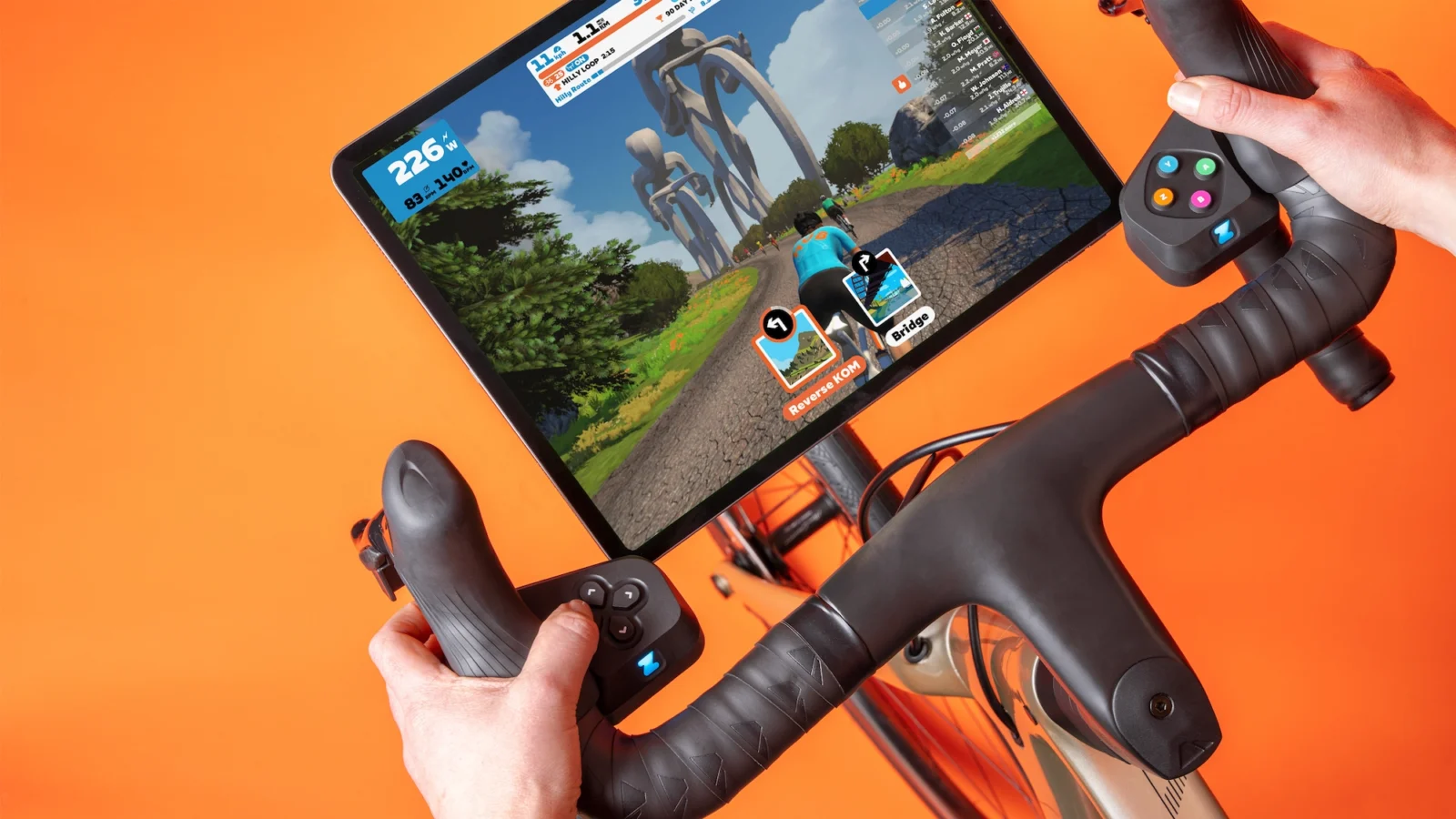
Companies like Orangetheory and EGYM are using gamification to build community and motivate people to work out with their peers
While many fitness enthusiasts enjoy breaking a sweat, making a workout both competitive and fun while harnessing the latest in technology can attract those who don’t, offering major benefits for fitness companies.
Major players are emerging in the fitness gamification space, luring in reluctant exercisers with competitive activities, dopamine spikes and socialization opportunities.
Athletech News spoke with some of the leading companies that are redefining what gamification means for the future of the fitness industry.
Orangetheory, the Masters of Gamification
Orangetheory Fitness, which added 200 new studios during the pandemic years, is gearing up for rapid growth, believing that demand is exceptionally high for its boutique fitness concept.
The fitness company has mastered gamification with its heart rate, performance tracking and in-studio monitors that directly connect to Orangetheory’s wearable.
Orangetheory’s gamification approach has gotten fitness consumers interested in real-time data, which has become a bedrock of the brand. The boutique fitness company boasts a “Challenge Tracker” to track past and current performances for fitness milestones, such as a one-mile treadmill time or a member’s best 2000-meter rowing distance. Members who are motivated by competition can see where they land on the leaderboard, working to increase speed or stretch over time.
“Gamification in the fitness space has always been — and I think will remain — an impactful way to motivate people to attain their goals,” said Rachel Vaziralli, Orangetheory’s director of fitness design. “Gamification has been shown time and time again to push people to find their max potential because competition, whether with yourself or others, drives people to work harder and can also help you adhere to a workout program that you might otherwise quit.”
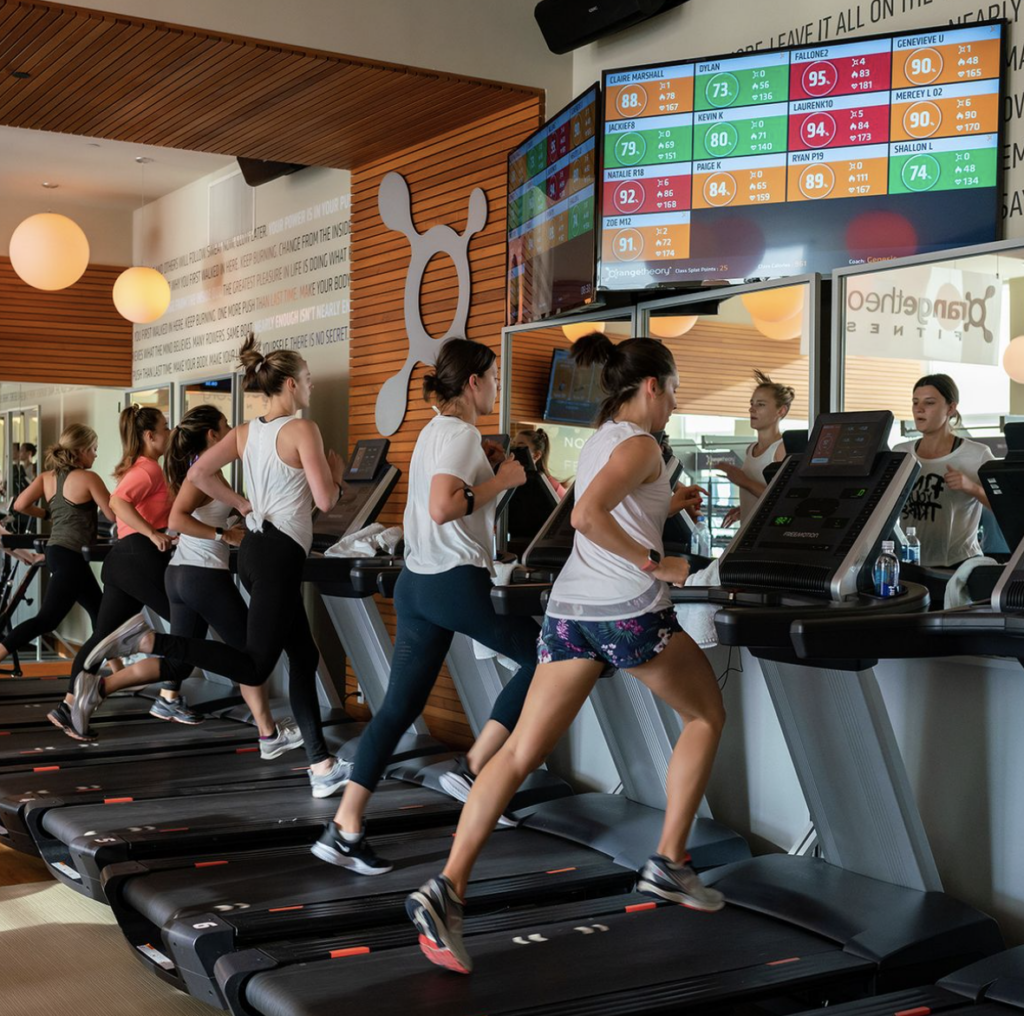
Vaziralli notes that fitness gamification can come in various forms, using both digital and non-digital platforms.
“At Orangetheory, we like to do both, and we look at gamification in multiple ways, like workout events, thematic classes, and through our tech,” she added.
She points to Orangetheory members participating in a personal achievement journey where they can track progress over time or join a 30-day challenge where they commit to workouts, hydration and mental health, using a tracking card to help stay in the game.
Orangetheory also incorporates gamification in its events, offering a chance to hit new goals and test limits, such as a week-long event in October called Hell Week and another in May called Mayhem.
The boutique fitness company also integrates socialization and teamwork with gamified workouts such as Capture the Flag, where two Orangetheory members partner. The friendly and fun competition engages the entire class, measuring them against other Orangetheory classes worldwide and sharing results on social media.
As Orangetheory looks to the future, it sees an opportunity to continue to blend its gamification expertise with strength training, which is becoming highly popular among fitness consumers.
“As people continue to learn the importance of incorporating strength training into their workouts, the need to find ways to engage exercisers with gamification in that space will continue to rise,” said Vaziralli.
EGYM Invests in Competition Tech
EGYM is all in on gamification and AI, believing that the fitness industry needs to lean into advancing tech.
The company, creating products for club operators and members, has experienced rapid growth. In 2022, EGYM reported year-over-year growth of over 200% in North America, with plans to more than double again this year. Earlier this month, the Munich-based company raised $225 million in a funding round led by Affinity Partners as it eyes an eventual IPO.
“As a reflection of the importance and impact of gamification in everyday life, at EGYM we believe the application of gamification will continue to increase and accelerate in the fitness industry,” said Dana Milkie, General Manager, EGYM North America. “Gamification will play a pivotal role in helping operators provide a more engaging, motivating and hyper-personalized experience for their members.”
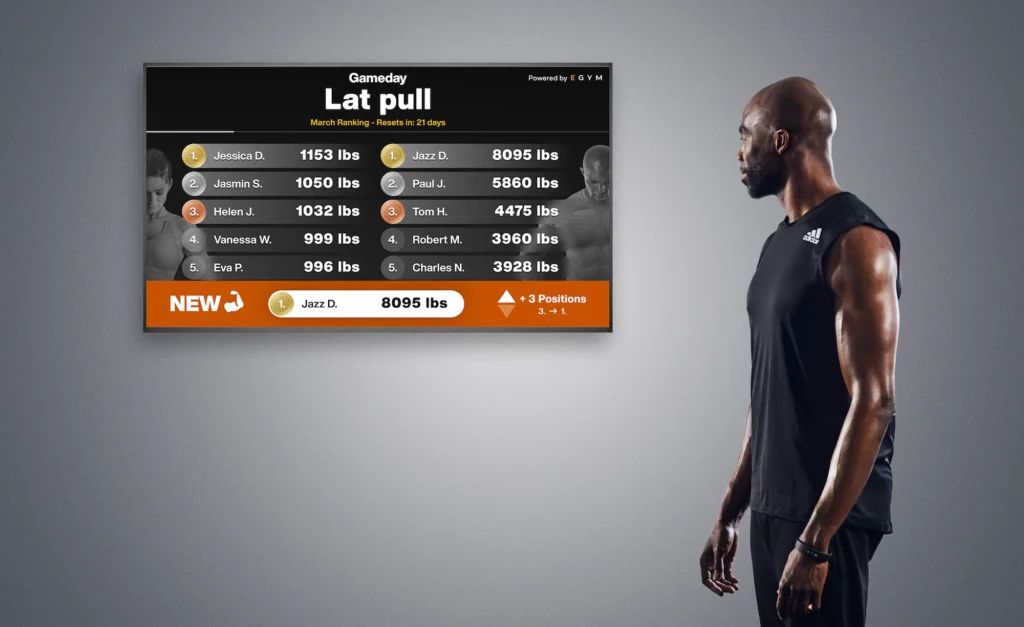
Milkie points to EGYM’s latest innovation, Gameday, as an example of how gamification can make a huge difference for health club operators and members.
“Designed to create competition within and between members, Gameday leverages a ‘total weight moved’ leaderboard to enhance members’ workouts and allow for a unique experience for prospects,” said Milkie. “The results will instantly change your members’ workout routine and keep them engaged and motivated through gamification.”
Zwift Brings a New Dimension to Cycling
Valued at north of $1 billion, Zwift, an immersive multiplayer online cycling and running platform, is aiming to become the premiere leader in the interactive cycling space. Co-founder and co-CEO Eric Min believes there are millions of future Zwift-ers who are just sitting on the sidelines at the moment.
The virtually connected fitness company is excited about the gamification space and hopes to add other activities to its platform.
“The nice thing about gaming fitness is the limitless potential,” said Zwift’s Chris Snook, director, PR & external communications. “When we launched Zwift in 2014, our mission was to make more people more active, more often. We believed that by gamifying our cycling experience, we would help make indoor training more fun.”
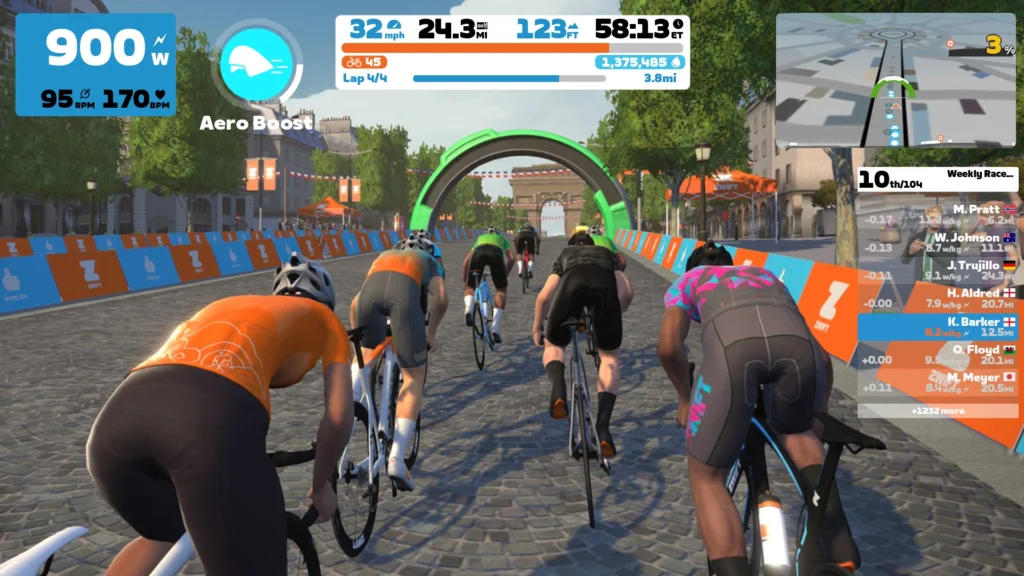
Snook added that Zwift and gamification, in general, represent a new opportunity to make people healthier while providing a more accessible way to exercise.
“Society in general is becoming more sedentary,” he said. “We believe that a platform like Zwift has the potential to help combat this by using technology to make fitness and exercise more fun, more social, and more convenient. The convenience of exercising from home removes barriers and also unlocks opportunities by presenting equal opportunities.”
Rewarding fitness enthusiasts is another angle that Zwift has mastered.
“We add many gamified elements in the Zwift that look to reward users for their efforts,” said Snook. Since Zwift doesn’t support in-app purchases, users can instead accrue Zwift’s virtual currency, Drops, which can result in receiving tangible goodies for Zwift players.
“Like XP points, Drops are awarded the more you ride or run and we offer bonus multipliers by riding for extended durations with our pacer groups or when riding up hills,” explained Snook. “These Drops can then be exchanged in the Drop Shop for new bikes, wheels and helmets.”
Looking ahead, Snook confirmed Zwift is also looking at virtual reality, especially with the opportunities presented by Web 3.0.
Quell Puts the ‘Game’ in Gamification
Quell, a gamified fitness developer, recently completed a Series A funding round, bringing its total funding to $15.6 million, which will fuel its launch game, Shardfall, and expand its video game library.
The gamified platform speaks to those who want an immersive experience that is unpredictable, slaying creatures and protecting an enchanted forest without realizing they are working up a sweat.
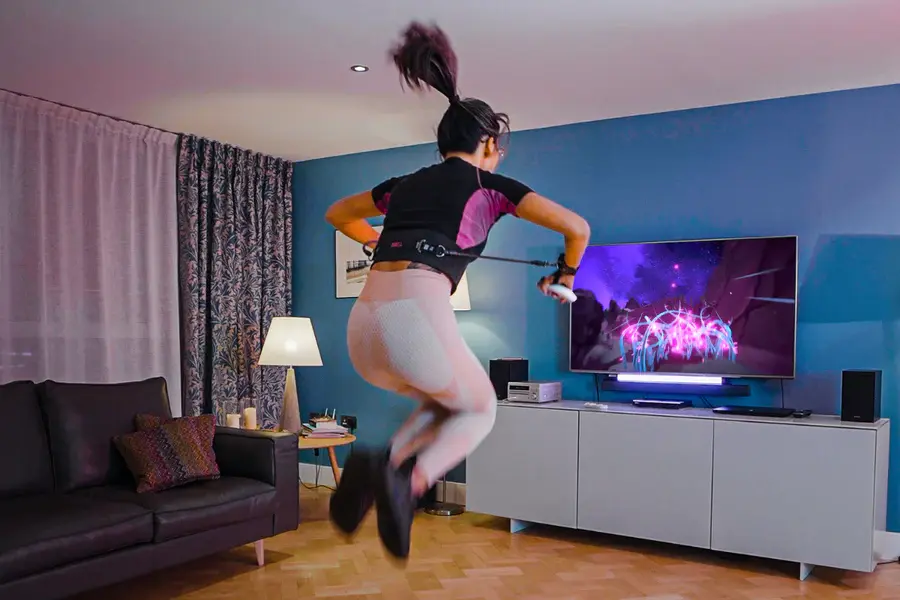
Cameron Brookhouse, co-founder and CEO of Quell, observes that gamification in some form or another has been a trend for roughly 30 years, with gaming features such as socialization and leaderboards constituting the components that make gaming appealing.
“To me, the future of gamification and fitness and wellness is transitioning from those kinds of light-touch integrations into full gamification where the game is the centerpiece,” said Brookhouse.
But it’s more than that, according to Brookhouse. It’s also recognizing and building upon human behaviors. In its journey to positioning its brand with a gaming-first approach, Quell conducted significant research into people’s fitness behaviors and perceptions. It also took an honest look at mainstream fitness activities.
“I think the core issue with fitness is what we call ‘default exercise’ – so things like running, cycling, the gym, which are really easy to access — are typically also really unpleasant for most people, either monotonous or boring or a bit painful,” explained Brookhouse. He cited some statistics that he finds amusing, including a Strava survey that revealed half of runners either hate or barely tolerate running.
“I think it’s amazing,” he said with a laugh. “What product has 50% of people hating using it, but they still use it? And then like 67% of U.S. gym memberships are completely dormant, right? So there’s kind of this broken thing in the space.”
That “broken thing” in the industry is what Quell believes can be easily fixed with the help of fitness gamification.
Brookhouse went on to say that when examining what makes exercise compelling, there’s a substantial overlap with what makes gaming enticing, which he says isn’t entirely surprising given that the most enjoyable fitness activities are effectively games.
“Team sports and things like that have really, really high enjoyment scores, but they’re also really hard to access,” he said. “But if you dig into these sorts of components of enjoyment, which I think is the future of gamification, it kind of sits along these pillars, like instantaneous and ideally variable rewards.”
While the fitness gaming space has elements such as leaderboards and rewards, Brookhouse believes competitors are missing one important aspect: immersion.
“We use that in a really specific way at Quell,” he said. “When we say immersion, we mean that every exercise and action that you’re doing is in the functional service of some obvious game goal. So nothing is abstracted, nothing is repetition, nothing is a plan — everything is responsive and everything makes sense functionally.”
Brookhouse thinks companies in the gamification business are missing the bigger picture.
“There’s a bunch of VR players in this space and some console players as well that are making kind of a classic design mistake,” he said. “They’re thinking, ‘OK, we’re making a fitness game, let’s make a game about fitness, let’s centralize fitness’ and what that ultimately does is just recreate the gym, recreate those low enjoyment, default exercises in your home. In this immersive setting, you basically simulated a gym with a sort of wrapper around it and some polish.”
In contrast, Quell makes the game the mission instead of the distraction, striving to recreate the fun of high-enjoyment exercises.
“I think that’s the future of this,” said Brookhouse.
He also shed light on Quell’s launch game: “It’s this beautiful sort of adventure RPG where you’re running and jumping and fighting your way through this incredible fantasy world. But the game and the AI are the things that are your personal trainer and it’s completely immersive.”
The game never demands that players do X number of jumps; instead, players are jumping because they are about to be attacked or running because the walls are closing in around them or they have to move quickly before getting hit with spikes. Brookhouse said that a system of unpredictability and intention makes Quell enjoyable.
Looking ahead, Quell is in the middle of its big launch year, debuting its wearable fitness gaming console and RPG game.
“It’s going to be kind of mind-blowing to see what the response to this is like,” said Brookhouse. “I don’t think anything like this exists out there yet. We’ve done a ton of new stuff on the hardware side, some really cutting-edge things with super lightweight motion tracking without any VR headsets or cameras or anything to impact the UX.”



